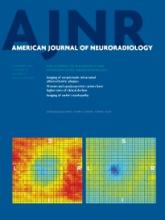Index by author
Koenig, K.A.
- FunctionalOpen AccessSex Differences in Resting-State Functional Connectivity in Multiple SclerosisK.A. Koenig, M.J. Lowe, J. Lin, K.E. Sakaie, L. Stone, R.A. Bermel, E.B. Beall, S.M. Rao, B.D. Trapp and M.D. PhillipsAmerican Journal of Neuroradiology December 2013, 34 (12) 2304-2311; DOI: https://doi.org/10.3174/ajnr.A3630
Kohrmann, M.
- InterventionalOpen AccessReduced Mortality and Severe Disability Rates in the SENTIS TrialP.D. Schellinger, A. Shuaib, M. Köhrmann, D.S. Liebeskind, T. Jovin, M.D. Hammer, S. Sen, D.Y. Huang, S. Solander, R. Gupta, R.R. Leker and J.L. Saver for the SENTIS Trial InvestigatorsAmerican Journal of Neuroradiology December 2013, 34 (12) 2312-2316; DOI: https://doi.org/10.3174/ajnr.A3613
Kollias, S.S.
- LETTERYou have accessReply:A. Hock, A. Henning and S.S. KolliasAmerican Journal of Neuroradiology December 2013, 34 (12) E130; DOI: https://doi.org/10.3174/ajnr.A3810
Konrad, C.
- BrainYou have accessChanges of Pituitary Gland Volume in Kennedy DiseaseC.C. Pieper, I.K. Teismann, C. Konrad, W.L. Heindel and H. SchiffbauerAmerican Journal of Neuroradiology December 2013, 34 (12) 2294-2297; DOI: https://doi.org/10.3174/ajnr.A3591
Koral, K.
- FELLOWS' JOURNAL CLUBPediatricsYou have accessDiffusion MRI Improves the Accuracy of Preoperative Diagnosis of Common Pediatric Cerebellar Tumors among Reviewers with Different Experience LevelsK. Koral, S. Zhang, L. Gargan, W. Moore, B. Garvey, M. Fiesta, M. Seymour, L. Yang, D. Scott and N. ChoudhuryAmerican Journal of Neuroradiology December 2013, 34 (12) 2360-2365; DOI: https://doi.org/10.3174/ajnr.A3596
DWI studies of 96 cerebellar pediatric tumors were analyzed by neuroradiologists and residents in radiology during 2 sessions, one that included the DWI studies and one that did not. These observers were asked to categorize the masses as: astrocytoma, medulloblastoma, ependymoma, or atypical teratoid/rhabdoid tumor. The addition of DWI resulted in significant improvement in the diagnosis of all tumors except ependymoma among all reviewers with different levels of experience.
Korutz, A.W.
- EDITOR'S CHOICEBrainOpen AccessT1 Gadolinium Enhancement of Intracranial Atherosclerotic Plaques Associated with Symptomatic Ischemic PresentationsP. Vakil, J. Vranic, M.C. Hurley, R.A. Bernstein, A.W. Korutz, A. Habib, A. Shaibani, F.H. Dehkordi, T.J. Carroll and S.A. AnsariAmerican Journal of Neuroradiology December 2013, 34 (12) 2252-2258; DOI: https://doi.org/10.3174/ajnr.A3606
The degree of contrast enhancement was assessed in 22 high-grade intracranial stenoses that were either symptomatic or asymptomatic. Seventy percent of symptomatic plaques showed contrast enhancement whereas this was seen in only 8% of those that were asymptomatic. This study suggests that intracranial stenoses can be evaluated with conventional MRI protocols and that there is a strong association between plaque contrast enhancement and ischemic symptoms.
Kota, G.
- BrainOpen AccessAutomated White Matter Total Lesion Volume Segmentation in DiabetesJ.A. Maldjian, C.T. Whitlow, B.N. Saha, G. Kota, C. Vandergriff, E.M. Davenport, J. Divers, B.I. Freedman and D.W. BowdenAmerican Journal of Neuroradiology December 2013, 34 (12) 2265-2270; DOI: https://doi.org/10.3174/ajnr.A3590
Krecke, K.N.
- FELLOWS' JOURNAL CLUBBrainYou have accessStroke-Like Migraine Attacks after Radiation Therapy (SMART) Syndrome Is Not Always Completely Reversible: A Case SeriesD.F. Black, J.M. Morris, E.P. Lindell, K.N. Krecke, G.A. Worrell, J.D. Bartleson and D.H. LachanceAmerican Journal of Neuroradiology December 2013, 34 (12) 2298-2303; DOI: https://doi.org/10.3174/ajnr.A3602
Clinical and imaging findings in 11 patients with SMART syndrome were reviewed. All patients became symptomatic on average 20 years postirradiation and all showed unilateral gyriform cerebral enhancement that resolved spontaneously in 2–5 weeks though 45% had residual neurologic deficits. Twenty-seven percent of patients developed laminar necrosis and brain biopsies of 4 patients showed nonspecific findings.








